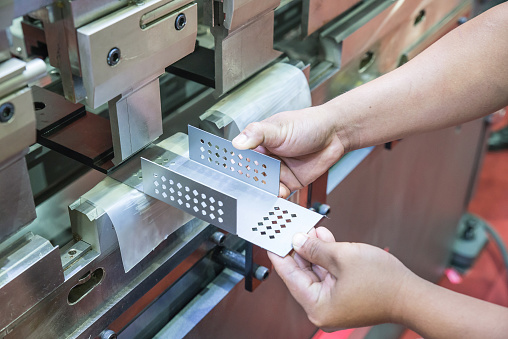Sheet Metal Fabrication; A Necessity.

Despite its importance, many people are unaware of the vast presence of sheet metal in everyday life. It’s fascinating how often we interact with objects and appliances that require sheet metal fabricated components.
As you’re reading this from your computer or mobile devices, you’re experiencing first-hand how sheet metal fabrication aids in the smooth running of electronic devices. All kinds of metal can be formed into thin pieces to create sheet metal; Titanium, Aluminium, Copper and Brass to name just a few, making sheet metal fabrication versatile to several applications. Products formed using sheet metal are extremely common in everyday life and vary in structure and size. From the cutlery in your kitchen draw to the plane jetting you off to sunny Tenerife; sheet metal fabrication is a necessity.
You’ll probably be familiar with the use of sheet metal fabrication within the construction industry, for smaller fabricated components such as nuts and bolts as well as larger elements of the construction project like fences, balconies, handrails, and ladders; various sized sheet metal components will work together to form a structure. If it wasn’t for sheet metal fabrication, today’s buildings would not be as structurally sound and emergency ready.
Looking around your kitchen, it is almost guaranteed that you will own at least one item that has been created using sheet metal fabrication. For example, large sheets of stainless-steel are used for household appliances such as refrigerators and washing machines, to create the outer casing of the appliance. It is the same kinds of sheet metal that you would also see as you’re walking down the street, forming the cladding on large scale buildings.
But are you aware that sheet metal fabrication is not only used for statuary objects? Sheet metal components play a very important role in the Automotive and Aerospace industry. Dating back to the 19th century, sheet metal fabrication was used to modify racing cars and engines for the grand prix, the first Grand Prix race took place in 1984 and all cars competing were specifically customised for the driver. Since then, the process has become a necessity within the car world. Vehicle customisation is still widely common in the present day and procedures are usually performed following the preference of the vehicle owner. This could be anything from the simple task of swapping a part, to a total transformation that requires rearranging the entire engine. With many people into the trend of vintage car restoration, sheet metal fabrication is commonly used by these industries to give old cars new life and keep them in shape.
In a nutshell, sheet metal fabrication is used to produce thousands of individual vehicle parts that are engineered and fitted to create the whole structure of an individual automobile. As well as this, the same can be said within the aerospace industry. The British aerospace industry is an advanced manufacturing sector, producing high tech components for several major aircraft companies. Their requirements for sheet metal fabrication rely heavily on precision and versatility as the parts must be precise and long-lasting regardless of temperature, humidity, and mechanical stress. A lot of components within an aircraft are fabricated, these include components for the harness, large enclosures for the main body of an aircraft and components for the chassis. Without this precision formed components, an aircraft would not be able to run.
Furthermore , it could be argued one of the most common uses of sheet metal fabrication is within Computer Electronics, where sheet metal can be cut, bent, and stamped to form the enclosures, houses and chassis that are vital in protecting sensitive equipment from wear and tear. The use of fabrication means the metal can be customised to a user interface with sections and cut outs created for buttons. Cut-outs can also be manufactured for cable connectors, fans, switches, and LED panels. As well as the enclosures, sheet metal can also be fabricated to create small parts such as brackets or cable connectors as metals such as aluminium, copper and brass are all strong enough to hold larger metal or plastic components together without breaking. Electronic devices also require a lot of small custom components like gears and washers, which are often used in hard drives and motherboards and can be fabricated quickly and affordably. Within computer electronics, sheet metal fabrication is popular as it provides a low-cost, high quality and fast turnaround solution.
Here at Hayward Miller, we work with a client who manufactures high quality general and precision sheet metal components and fabrications. Offering the full process from prototype to the production of volume thin sheet metal fabrications, they provide a variety of services to suit your needs.
If this is of any interest to you, don’t hesitate to reach out.
sheetmetal@haywardmiller.co.uk

